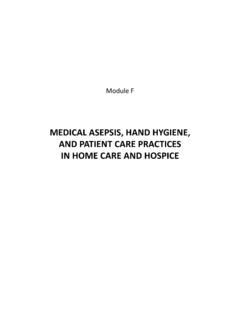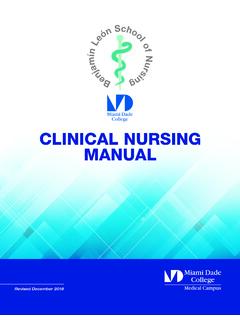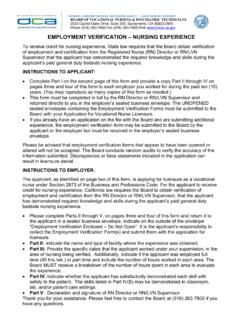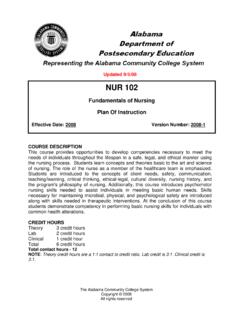Transcription of Prevention of Central Line- Associated Bloodstream ...
1 Prevention of Central Line- Associated Bloodstream Infections: Aseptic Insertion and Site Selection 1. Presenter Vineet Chopra, MD, MSc Associate Professor of Medicine Chief of the Division of Hospital Medicine University of Michigan Contributions by Kristi Felix, RN, BSN, CRRN, CIC, FAPIC. Madonna Rehabilitation Hospital Karen Jones, RN, MPH, CIC. University of Michigan Len Mermel, DO, ScM, AM (Hon). Medical School of Brown University Russ Olmsted, MPH, CIC, FAPIC. Trinity Health, Livonia MI. Payal Patel, MD, MPH. University of Michigan 2. Learning Objectives Explain the importance of preparing the site for Central venous catheter (CVC) insertion Recognize the role of various antiseptics in preventing Central line- Associated Bloodstream infections (CLABSIs). Describe the considerations for choosing a site for CVC insertion 3. Preparing the Site for CVC Insertion Skin antisepsis is a cornerstone of CLABSI Prevention Skin pathogens are a common cause of CLABSIs Especially for CLABSIs that occur within seven days of insertion Preparing the site appropriately can reduce risk of catheter-related infection Prevent transmission during insertion Reduce burden of bacteria on exit site 4.
2 Which Skin Preparation is Best? Available skin preparations include Chlorhexidine-gluconate (CHG). Aqueous Alcohol-containing Povidone-iodine Alcohol preparation without iodine or CHG. 5. Chlorhexidine-Gluconate as a Skin Antiseptic Compared to povidone iodine, chlorhexidine use for skin antisepsis significantly reduced risk of CLABSIs Risk Ratio (95%CI ). Favors Chlorhexidine Favors Povidine Iodine (Chaiyakunapruk N, Ann Intern Med, 2002). 6. The Role of Alcohol (Maiwald M, PLoS One, 2012). 7. What is the Active Ingredient? Is it the alcohol or the chlorhexidine that matters most? In identical concentrations of alcohol, does CHG. outperform povidone iodine? Does cleaning the skin with soap before catheter insertion make a difference? What concentration of chlorhexidine is best? 8. The CLEAN Trial Randomized controlled trial, n=2,546. 11 ICUs, six different hospitals in France Two-by-two factorial design, four treatment groups: CHG or povidone iodine for antisepsis Scrubbing with detergent versus no scrubbing (Mimoz O, Lancet, 2015).
3 9. The CLEAN Trial: Product Used 2% CHG to 70% isopropyl alcohol (Chloraprep). 5% povidone iodine (PI) to 69% ethanol Applied either as: 1 step: skin agent only 2 step: clean with detergent first, then apply agent Because products looked different, unable to blind clinicians, but assessors were masked (Mimoz O, Lancet, 2015). 10. The CLEAN Trial: Results (duration of catheter maintenance (days)). (Mimoz O, Lancet, 2015). 11. The CLEAN Trial: Summary CHG is superior to PI when administered in the same alcohol concentration Skin scrubbing is a relic of the past No longer necessary in an era of modern antiseptics and CHG use Alcohol-containing CHG should be standard for skin antisepsis prior to CVC insertion If the patient is allergic or under two months of age, PI is a reasonable alternative 12. Traditional Thinking About Site Avoid the femoral site Higher bacterial density Harder to keep clean Core component of Keystone study, CLABSI Bundle What about the jugular site? Problematic to keep site clean, dry, intact Dressing, oral secretions, weight of catheter/tubing How do femoral and jugular vein placement compare to subclavian placement?
4 13. Is the Femoral Site Really Worse? Randomized controlled trial with 750 adult patients requiring acute renal replacement therapy From 12 hospitals in France Randomized to jugular or femoral catheter site placement Results: More hematomas in the jugular group No difference in rate of catheter-related Bloodstream infection (Parienti JJ, JAMA, 2008). 14. More Data Questioning Site Systematic review of randomized or prospective cohort studies Reviewed 19 studies and 10 were included in the meta-analysis Only one randomized site of insertion Results: Risk of infection lower for subclavian site versus jugular and femoral sites RR [95%CI= ]. When one large study was excluded, no difference in risk between femoral and subclavian site (Parienti JJ, Crit Care Med, 2012). 15. Definitive Data 35. 30. Number of Catheters with 25. Complications 20. Mechanical complications 15 Symptomatic deep vein thrombosis 10 Bloodstream infection 5. 0. Subclavian (N=843) Jugular (N=845) Femoral (N=844). Insertion Site Group Subclavian site Associated with lower risk of catheter- related Bloodstream infection and deep vein thrombosis, but higher risk of pneumothorax.
5 (Parienti JJ, N Engl J Med, 2015). 16. What About Skin asepsis and Site for Peripherally Inserted Central Catheters (PICCs)? Limited data available Avoid antecubital site or sites around elbow Increase kink of catheter, which increases failure Higher bacterial density on skin, aka the groin of arm . Upper arm placement under ultrasound guidance Associated with reduction in CLABSI. Placement of PICCs in ICU settings same risk of CLABSI as traditional CVCs (Harnage SA, JAVA 2007; Yokoe DS, Am J Inf Control, 2014; Chopra V 2013, Marschall J, 2015). 17. Summary Alcohol-containing chlorhexidine-gluconate is the most effective skin antisepsis at reducing CLABSI. For patients allergic to CHG, povidone iodine is a suitable alternative Weigh the risk of infection against the risk of mechanical complications when placing Central venous devices Subclavian placement has the lowest risk of infection but highest risk for insertion-related complications No clear difference in infection risk between jugular and femoral sites PICCs have similar rates of infection as CVCs Avoid the antecubital fossa Use ultrasound guidance for insertion 18.
6 References Chaiyakunapruk N, Veenstra DL, Lipsky BA, et al. Chlorhexidine compared with povidone-iodine solution for vascular catheter-site care: a meta analysis. Ann Intern Med. 2002; 136(11): 792-801. Harnage SA. Achieving zero catheter related blood stream infections: 15 months success in a community based medical center. JAVA. 2007; 12(4): 218-25. Maiwald M, Chan ES. The forgotten role of alcohol: a systematic review and meta-analysis of the clinical efficacy and perceived role of chlorhexidine in skin antisepsis. PLoS One. 2012; 7(9): e44277. McNeil CR, Rezaie SR, Adams BD. Central Venous Catheterization and Central Venous Pressure Monitoring. Clinical Procedures in Emergency Medicine. 2014; 6: 397-431. Mimoz O, Chopra V, Timsit JF. What's new in catheter-related infection: skin cleansing and skin antisepsis. Intensive Care Med. 2016; 42(11):1784-6. 19. References (cont'd). Mimoz O, Lucet JC, Kerforne T, et al. Skin antisepsis with chlorhexidine-alcohol versus povidone iodine-alcohol, with and without skin scrubbing for Prevention of intravascular-catheter-related infection (CLEAN): an open-label, multicenter, randomized, controlled, two-by-two factorial trial.
7 Lancet. 2015; 386(10008): 2069-77. Parienti JJ, Mongardon N, M garbane B, et al. Intravascular complications of Central venous catheterization by insertion site. N Engl J Med. 2015; 373: 1220-1229. Parienti JJ, duCheyron D, Timsit JF, et al. Meta-analysis of subclavian insertion and nontunneled Central venous catheter- Associated infection risk reduction in critically ill adults. Crit Care Med. 2012; 40(5): 1627-34. Parienti JJ, Thirion M, M garbane B, et al. Femoral vs jugular venous catheterization and risk of nosocomial events in adults requiring acute renal replacemtn therapy: a randomized controlled trial. JAMA. 2008; 299(2): 2413-22. Yokoe DS, Anderson DJ, Berenholtz SM, et al. A compendium of strategies to prevent healthcare- Associated infections in acute care hospitals: 2014 Updates. Am J Infect Control. 2014; 42(8): 820- 8. 20. Speaker Notes 21. 21. Speaker Notes: Slide 1. This module, titled Prevention of Central Line- Associated Bloodstream Infections: Aseptic Insertion and Site Selection, will provide background information on the importance of asepsis during catheter insertion and site selection as a means to prevent CLABSI.
8 22. Speaker Notes: Slide 2. This module was developed by national infection Prevention experts devoted to improving patient safety and infection Prevention efforts. 23. Speaker Notes: Slide 3. After completing this module, you will be able to: Explain the importance of preparing the site for Central venous catheter, or CVC, insertion, Recognize the role of various antiseptics in preventing Central line- Associated Bloodstream infections, or CLABSIs, and Describe the considerations for choosing a site for CVC. insertion. 24. Speaker Notes: Slide 4. Skin antisepsis is a cornerstone of CLABSI Prevention . If the skin is not cleaned properly, pathogens can migrate along the external surface of the catheter from the skin entry site. Thus, skin pathogens are a common cause of CLABSI, especially within the first seven days of CVC insertion. Appropriately preparing the insertion site can dramatically reduce the risk of catheter-related infections. This antisepsis both prevents transmission during insertion and reduces the burden of bacteria on the exit site.
9 25. Speaker Notes: Slide 5. Available skin preparations include: chlorhexidine-gluconate, both aqueous and alcohol-containing, povidone-iodine and alcohol preparation without iodine or chlorhexidine. So, which skin preparation is the best to prevent CLABSI? 26. Speaker Notes: Slide 6. An important meta-analysis by Chaiyakunapruk and colleagues in 2002 compared the use of povidone iodine solution with the use of CHG for skin antisepsis in the Prevention of CLABSIs. This systematic review found that compared to povidone iodine, skin disinfection with CHG reduced the risk of CLABSI by almost 50 percent. 27. Speaker Notes: Slide 7. Alcohol plays a special role in combination with chlorhexidine. Data on this slide are from a review and meta-analysis of the clinical efficacy of chlorhexidine for skin antisepsis for Prevention of intravascular catheter- Associated infections. The top panel shows three studies comparing chlorhexidine without alcohol to povidone iodine. There was no statistically significant difference in the risk of CLABSI between those two solutions.
10 28. Speaker Notes: Slide 7 Continued The bottom panel shows studies comparing alcohol-containing chlorhexidine and povidone iodine. Here, the overall effect estimate (depicted as the black diamond) is significantly in favor of the chlorhexidine-alcohol combination. This study suggests that its not just chlorhexidine, but alcohol that also matters. 29. Speaker Notes: Slide 8. But which element of the bundle is the active ingredient? . Is it the alcohol or chlorhexidine component that matters most? Similarly, does skin cleaning with soap before inserting a catheter make a difference? And what concentration of chlorhexidine is best for preventing infection? The next few slides will explore these three critical questions. 30. Speaker Notes: Slide 9. The CLEAN trial, published in 2015, helps answer these questions. This randomized controlled trial examined whether skin antisepsis with chlorhexidine-alcohol, versus povidone iodine- alcohol, with or without skin scrubbing, was effective in preventing catheter-related infection.

















